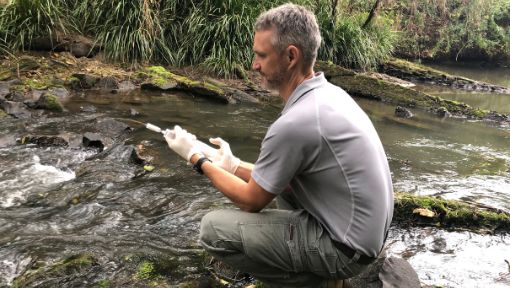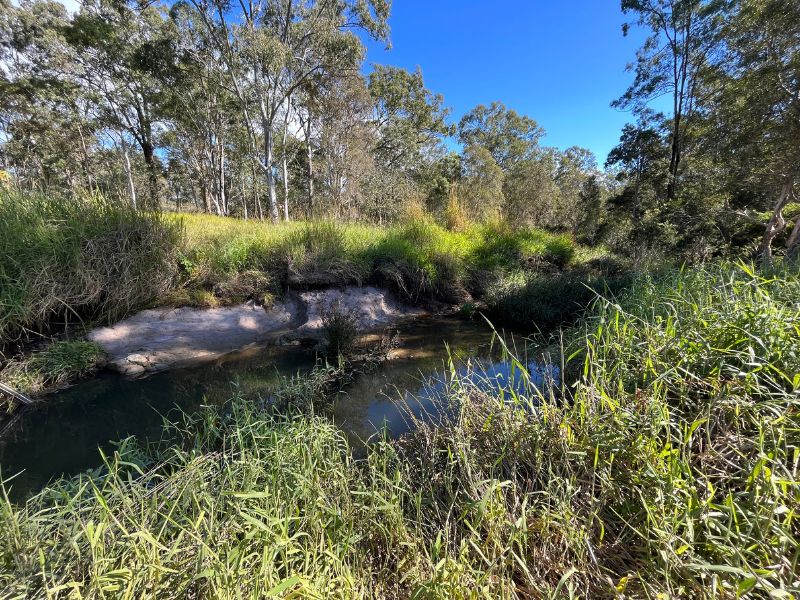Greater Brisbane Platypus eDNA Surveys Project
Plotting platypus distribution one water sample at a time
© Tamielle Brunt
As Greater Brisbane grows in urbanisation, the pressures placed on freshwater ecosystems and the resources that platypuses need to survive also increase.
Noticing a decline in reported platypus sightings, in 2016 Wildlife Queensland initiated this project to use a new and exciting monitoring method, called environmental DNA (eDNA), to sample waterways for evidence of platypuses. Funds raised from the PlatyCount 2016 campaign appeal helped establish the project, which aims to:
- accurately identify platypus presence in selected waterways using the eDNA method
- establish a longitudinal platypus survey in key locations across Queensland
- identify platypus distribution changes over time
- determine habitat quality in association with platypus presence.
Since launching with 66 sites sampled, the project has now grown to 300+ sites sampled across 115 waterways in 6 Local Government Areas. The team works closely with local councils, researchers and citizen scientists.
This eDNA program is crucial for monitoring this elusive species and has revolutionised how PlatypusWatch project officers identify population strongholds, increasing our understanding of platypus distribution within the state.
 © Wildlife Qld
© Wildlife Qld
Project Officers Tamielle Brunt and Hannah Thomas in the field.
 © Tamielle Brunt
© Tamielle Brunt
Projects Manager Matt Cecil taking a water sample.
2023 project results
sites sampled
waterways
local government areas
positive sites (in 29 waterways)
2023 was our biggest year of eDNA sampling since launching the program in 2016, with 302 sites sampled across 115 waterways.
49 sites in 29 waterways tested positive for the presence of platypus DNA.
The region’s six major councils have committed to an extensive two-year sampling regime across their LGA’s which will develop an occupancy model for the region. This will determine a percentage of change over time and a habitat suitability and flow regime models which will help us focus management actions to the region.
Over the eight years, we have been able to keep tabs on platypus populations to understand where they are persisting and work with councils to identify some areas that need more management, but this extensive sampling will allow for a more rigorous temporal and spatial analysis into the populations to efficiently focus resources.
Persisting platypus populations:
- Caboolture River
- South Pine River
- Lower Brisbane River
- Albert and Upper Logan Catchments.
Further investigations will be conducted in the Upper Bremer Catchment to understand connectivity along waterways due to isolated DNA detection in Reynolds Creek.
PlatypusWatch Wolston Centenary Surveys
Wildlife Queensland PlatypusWatch, in partnership with the Wolston and Centenary Catchments (WaCC), developed a community platypus observational and environmental DNA (eDNA) project to monitor the iconic platypus in a vulnerable area of Brisbane.
In June 2023, surveys were conducted at 10 sites across the four main waterways comprising the Wolston Catchment, located west of Brisbane:
- Sandy Creek
- Bullockhead Creek
- Ric Nattrass Creek
- Wolston Creek.
The project was proudly supported by the Lord Mayor’s Environment Grant.
 © Tamielle Brunt
© Tamielle Brunt
Platypus survey site in the Wolston Catchment.
2022 project results
Our 2022 eDNA survey collaborations with three councils resulted in highlighting waterways that are strongholds for platypus populations, even after 2019’s drought, 2020’s fires, and the more recent floods.
The Moreton Bay region, particularly, has had consistently positive eDNA detections over the years. Platypus populations are also persisting in the North Pine and South Pine Rivers, despite visible signs of erosion and sedimentation in the urban areas of these catchments.
Upper Caboolture River
The difference between the upper Caboolture River, intact riparian zone and the Bremer River.
Bremer River
The Bremer River has a <10m buffer riparian zone of Lomandra and M. viminalis; following that, the weeds died after being inundation.
Albany Creek
Albany and Sandy Creeks are tributaries of the South Pine River that were impacted by sediment, which can smother platypus’s main food source.
Sandy Creek
What is eDNA?
Video created by EnviroDNA
All animals shed DNA into their surrounding environment as they slough off skin and hair cells and leave other body secretions; this is called eDNA. Researchers can collect samples of water or soil from these environments to detect what lives there.
The semi-aquatic platypus spends over 10 hours a day in the water. They shed cells while swimming and we can collect it in a water sample. These samples tell us whether platypuses are present or absent, but they cannot tell us how many individuals are there or their exact locations.
Mapping these monotremes
Wildlife Queensland has been working with Australian ecological research and services consultancy BioGeo to map the distribution of platypuses in Queensland. Using both observational data from the community and presence/absence data from eDNA, BioGeo is developing a model to pinpoint the habitat niche of the platypus, which helps focus conservation efforts by identifying where platypuses are likely to reside or where reintroductions would have the greatest likelihood of success.
In conjunction with eDNA sampling, we assess habitat quality at each site, including features that are preferable to platypuses, such as high stable banks, vegetation cover, pool depth and cobbled substrate, as well as overall waterway health.
Each site is scored on a Habitat Quality Index, which allows us to identify sites or areas that require rehabilitation. Some areas close to urbanisation are vulnerable to erosion and pollution; therefore, we can take action to reduce further degradation of platypus habitat.
Ongoing activities
This ongoing project will continue to:
- raise awareness about the platypus, its threats, and its conservation needs
- collect and collate observational and water sampling data on platypus populations
- encourage collaborations and engage local residents and citizen scientists in hands-on conservation efforts to rehabilitate waterways and support platypus populations
- expand the eDNA project throughout the state of Queensland
- advocate for increased protection of platypuses in Queensland through local and federal regulations.
Environmental DNA sampling has enabled PlatypusWatch to work closely and quickly with stakeholders to inform conservation actions and management decisions, such as areas to be rehabilitated for platypuses. With just a simple water sample sent to a lab, we can now tell whether platypuses are present or absent from particular waterways.
Partners & sponsors
- Ipswich City Council
- Logan City Council
- Moreton Bay Regional Council
- Brisbane City Council
- Redland City Council
- Brisbane Airport Community Funds
- Seqwater
- Scenic Rim Regional Council




